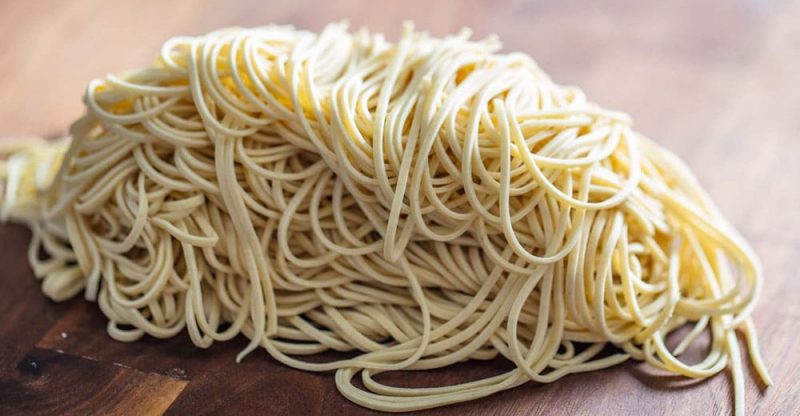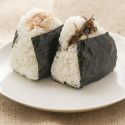What’re the Uses of Potassium Carbonate E501(i) in Food and other Common Applications?

Food | Ramen noodles | Glass | Ceramics
Potassium carbonate or pearl ash, is an alkaline with the chemical formula K2CO3, when used in food, it has the European food additive number E501(i). Its main uses are in glass, ceramics compared with the applications in food.
How is Potassium Carbonate Made?
Potassium carbonate, the main component of potash and was primarily derived from mined salt potash. The old method was collecting or producing from wood ash (1). Currently, it is mainly synthetically produced by the following three manufacturing processes (2):
1. Obtaining potassium hydroxide first by electrolysis of potassium chloride and then reacting with carbon dioxide. Chlorine (Cl2) and hydrogen (H2) are the byproducts. This is the most used commercial method and also the way to produce potassium hydroxide. The following is the chemical equation for this process:
- 2 KCl + 2 H2O → 2 KOH + H2 + Cl2
- 2 KOH + CO2 → K2CO3 + H2O
2. Treating a solution of potassium hydroxide with excess carbon dioxide. 2KOH + 2CO2 = K2CO3
3. Carbon dioxide gas is passed into the potassium hydroxide solution to produce potassium bicarbonate first, then heated. 2KOH + 2CO2 + H2O= 2KHCO3 2KHCO3= K2CO3 + CO2 + H2O
The above three methods are mainly used to produce heavy potassium carbonate, which has a higher density than its light type, the latter can be produced by the ion exchange method: (NH4)2CO3 + KCl
Potassium carbonate hydrate is formed after the process of crystallization and drying from the above solution, which can further be heated above 200°C to obtain potassium carbonate anhydrous.
Properties
| Other names | Potash, Pearl ash, Carbonate of potash, K carbonate |
| CAS number | 584-08-7 |
| Chemical formula | K2CO3 · nH2O, n = 0 Anhydrous, n = 1.5 Sesquihydrate |
| Molecular weight | 138.20 (anhydrous) |
| pH of 10% K2CO3 | 11.6 |
| Melting Point | 1636°F (891°C) |
Appearance
- Anhydrous: white, very hygroscopic powder, easy to absorb water in air and may agglomerate.
- Hydrate: white, free-flowing, dustless, translucent crystals or granules.
- It is also available in liquid type in the market.
Solubility
Very soluble in water with the solubility 113.5 g/100ml at 25ºC, better solubility than sodium carbonate. It forms a strongly alkaline solution when dissolved in water and dissociates potassium cation (K+) and carbonate anion (CO32–) as the following equation.
K2CO3 ===> K+ + CO32–
CO32- is amphoteric and exists the following carbonic acid equilibria:
CO32- + H2O <===> HCO3- + OH-
HCO3- + H2O <===> H2CO3 + OH-
Insoluble in ethanol.
What’re the Uses of Potassium Carbonate?
Potassium carbonate is a water-soluble salt with its main applications in the production of glass, detergents (soaps), ceramics, fertilizers, agrochemicals, pharmaceuticals, food, feed, fire extinguisher, drying agent for solvents and etc.
Potassium carbonate can be divided into heavy and light types if from density and solubility. The heavy type is mainly used in the fields of glass, ceramics, and fertilizers, while the light potassium carbonate is mainly applied in the fields of food, pharmaceuticals, and agrochemicals.
Food
Its food grade is mainly used as an acidity regulator and its common food uses as follows:
- Cocoa: it can be used in the manufacturing of alkalized cocoa to reduce the acidity of natural cocoa beans and darken cocoa powder.
- Wine: it can also be used as a buffering agent to lower acidity during wine production.
- Bakery: it was commonly used as a leavening agent to rise bread in baking but later replaced by sodium bicarbonate due to the bitter aftertaste. But can be used as a substitute of sodium bicarbonate in baked goods where low sodium content is desired.
- Ramen Noodles: the main ingredient in Kansui, which is used to improve texture and color.
- Marinades: as a buffering agent in marinades for meat.
- Milk powder: an acidity regulator in milk and cream powders.
- Raisins: as a drying agent for turning grapes into raisins.
Ramen noodles
While enjoying the ramen, are you curious why ramen noodles can be stretched so long and not break after repeated stretching?
It is potassium carbonate, which interacts with protein and therefore hardens the texture of ramen noodles, makes it elastic and changes the color. It raises the pH of dough and also helps shorten the cooking time of noodles.
Potassium carbonate and sodium carbonate are two main components in Kansui (lye water) to make noodles. The proportion of the former is higher when used with wheat flour to make thin ramen noodles, which has a high protein content. While the percentage of latter is high when used to soften the noodles with low protein content.
Glass
It was reported by the top USA manufacturer Armand that more than 44% of the total consumption of potassium carbonate is in glass production, which improves glass transparency, electrical resistivity, strength and refractive index. It is a source of K2O for alkali barium, lead or strontium silica glasses which are used in television tubes, laboratory glass, optical glass and etc. (3)
Ceramics
Potassium carbonate can be used as a raw material for ceramic frit in ceramic production. Its main purpose is to lower the frit melting temperature and increase the value of the frit expansion coefficient. It exists as K2O in the frits and commonly used in titanium dioxide frits for the appliance industry.
Soap
It can be used to make soap softer than sodium based soaps.
Is Potassium Carbonate Safe to Eat?
Together with potassium bicarbonate, they’re both naturally occurring inorganic compounds (4), which almost have no side effects and their safety as food additives has been approved by the FDA, EFSA and JECFA and other authorities.
FDA
Potassium carbonate is generally recognized as safe (GRAS) as a direct human food ingredient. It is used as a flavoring agent and adjuvant, nutrient supplement, pH control agent, or processing aid in food with no limitation other than current good manufacturing practice. (5)
EFSA
Potassium carbonate E501(i) is listed in Commission Regulation (EU) No 231/2012 as an authorised food additive and categorized in “ Additives other than colours and sweeteners” (6).
JECFA
Function Class: food additives, acidity regulator. (7)
Acceptable daily intake: ADI “not limited” was set in 1965. (8)
Conclusion
Now you may have a knowledge of the multifunctional ingredient – Potassium carbonate E501(i), from the following aspects:
- Four production processes
- The difference (density and solubility) between heavy and light potassium carbonate and their uses
- Uses in cocoa, wine, bakery, ramen noodles, glass, ceramics and etc
- Safety
What kinds of food labels have you found this ingredient in? Let me know in the comments.
Featured image source



I’ve found it in Cadbury cocoa, and I’m concerned about its effects on human health. What are the side effects?
Hi Okolie,
Potassium carbonate is generally safe.
What are the potential side effects, if any? What conditions normally cause these (e.g. high consumption etc.)?
Thank you in advance!